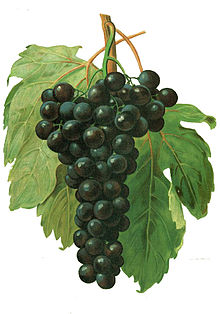Alphonse Lavallée
The red wine variety Alphonse-Lavallée is a new breed between the grape varieties Kharistvala Kolkhuri (syn. Gros Colman) x Muscat Hamburg. The earlier assumption that Alphonse-Lavallée was a cross between Bellino x Lady Downe's Seedling could not be confirmed. It was named after Pierre Alphonse Martin Lavallée , the then President of the Société d'Horticulture de France . The crossing took place, according to Pierre Galet around the year 1860 in the French city of Orléans .
It is used as a table grape ; the area covered with trees worldwide ( Argentina , Australia , Austria , Chile (4,816 hectares, as of 2006), Canada , Germany , France (886 hectares, as of 2007), India, Turkey , South Africa ) is around 10,000 hectares . In Belgium it was successfully grown in greenhouses for a long time.
It is susceptible to trickling and fungal diseases ( powdery mildew , downy mildew of the grapevine , gray mold rot ) and not very hardy. The vine is very productive and produces grapes with a relatively neutral taste. It ripens about 3 weeks after the Gutedel grape variety and is therefore considered to ripen moderately late. Alphonse Lavallée is a variety of the noble grapevine ( Vitis vinifera ). It has hermaphroditic flowers and is therefore self-fruiting. In viticulture , the economic disadvantage of not having to grow male plants that produce yield is avoided.
In California (→ Viticulture in California ) and South America, the grape variety is usually called Ribier or Ribier Noir . In France, however, there is also an independent grape variety Ribier that is not related.
Approved Clones: 319-797-798-799-857.
The variety was a cross-breeding partner in the Cardinal new breed . See also the list of grape varieties .
Synonyms
The grape variety Alphonse-Lavallée is also known under the names Afrikai Szoeloe, Alfons, Almeria Negra, Alphonso Lavalee, Ansleys Large Oval, Argentine, Barbarou, Blauer Damascener, Black Marocco, Black Muscadel, Blue Geisdutte, Blue Olive Grape, Cespljevna, Enfes, Entes, Garnacha Roja, Gros Noir or Grosse Noir, Karatopalak, Moltge, Oktyabrskii, Persia, Prince Royal Albert (the grape celebrated its first successes in British greenhouses), Raisin d'Afrique, Raisin du Jerusalem, Raisin St. Antoine, Ribier, Ribier Noir , Rimpie, Royal (this Belgian variety is said to be a mutation of Alphonse-Lavallée; also called Royal Emile Terheyden or Royal Belge) and Slyvovy.
Parentage: Kharistvala Kolkhuri × Muscat de Hambourg
Individual evidence
- ↑ Javier Ibáñez, Alba M. Vargas, Margarita Palancar, Joaquín Borrego, M. Teresa de Andrés: Genetic Relationships among Table-Grape Varieties . In: American Journal of Enology and Viticulture. Vol. 60, No. 1, 2009, ISSN 0002-9254 , pp. 35-42.
- ↑ Catastro Viticola Nacional 2006. (PDF; 135 kB) División Protección Agrícola - SAG, 2007, accessed on November 26, 2014 (Spanish).
- ↑ Les Cepages Noirs dans le Vignoble (PDF) ( Memento of January 20, 2007 in the Internet Archive ), statistics on red grape varieties per Greater Region, Part 1, publication by the Office National Interprofessionnel des Fruits, des Legumes, des Vins et de l'Horticulture - ONIVINS, as of 2008
- ↑ Les Cepages Noirs dans le Vignoble (PDF) ( Memento from March 1, 2012 in the Internet Archive ), statistics on red grape varieties per greater region, part 2, publication by the Office National Interprofessionnel des Fruits, des Legumes, des Vins et de l'Horticulture - ONIVINS, as of 2008
Web links
- Alphonse-Lavallée in the database Vitis International Variety Catalog of the Institute for Grapevine Breeding Geilweilerhof (English)
literature
- Pierre Galet : Cépages et vignobles de France. Volume 1: Les vignes Américaines. 2e édition, entièrement refondue. Paysan du Midi, Montpellier 1988, ISBN 2-902771-03-7 .
- Pierre Galet: Dictionnaire encyclopédique des cépages. Hachette, Paris 2000, ISBN 2-01-236331-8 .
